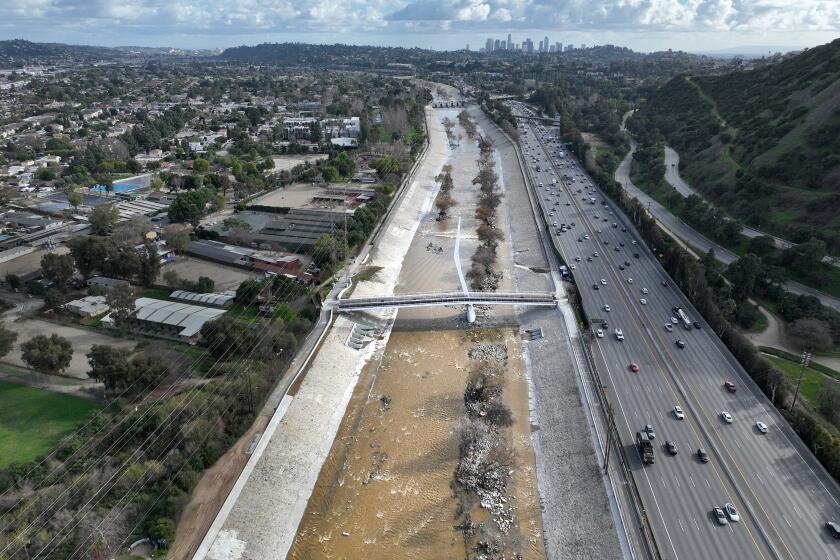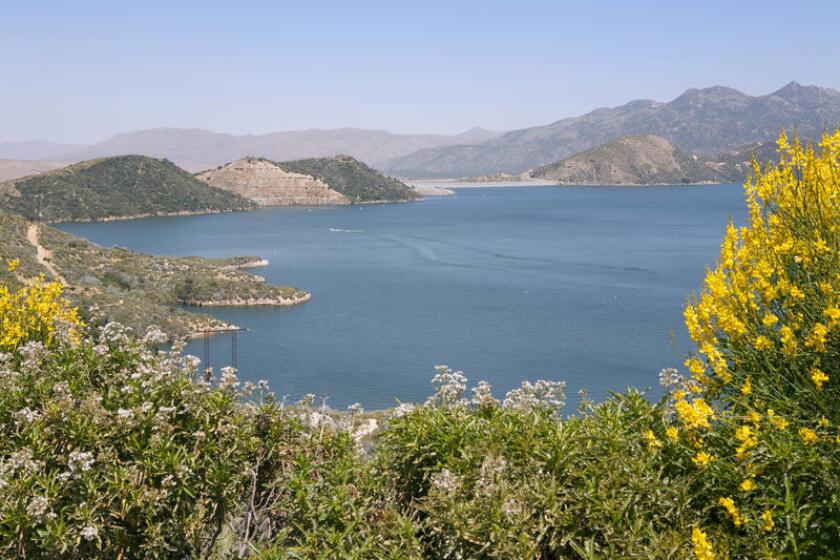
Robert Zavala was fresh out of the Marines and looking to escape dead-end work at a poultry plant in the early 1990s when his old baseball coach — now the head of a local water district — swooped to the rescue with a job offer.
Zavala was grateful for the job, which eventually paid more than $150,000 a year and included perks such as free housing and a new truck. Grateful enough, he later testified in state court, that when he learned the public agency he worked for was stealing water from the federal government he kept his mouth shut. For years.
And then one day in 2016, FBI agents showed up at his house.
“They told me they were investigating my boss for water theft, and they wanted to know if I wanted to go to federal prison with him,” Zavala said in his testimony.
Zavala became one of many employees the FBI would interview about goings-on in the Panoche Water District, a public agency formed in 1951 that supplies irrigation for 38,000 acres of farmland in Fresno and Merced counties on the parched western side of the San Joaquin Valley.
The stories were “unimaginable,” one Panoche official later testified in the same civil case. Public funds were allegedly used to pay for housing and pickup trucks for employees, along with slot machines, illicit home remodels, tickets to Katy Perry concerts, even an employee’s court-ordered restitution for an assault charge, according to testimony in the civil case, court filings in a state criminal case and a related state audit.
Not to mention the alleged theft of 130,000 acre feet of water — enough to supply a small city for several years.
Federal prosecutors would eventually bring felony charges against Zavala’s old boss, the former general manager of the Panoche Water District, accusing him of one of the most audacious and long-running water heists in California history.
In a state with prolonged bouts of drought and unquenching thirst, stolen water is an indelible part of California lore. But this was not Los Angeles’ brazen gambit to take water from the Owens Valley. Or San Francisco’s ploy to flood part of Yosemite National Park for a reservoir. The water grab described in a federal indictment allegedly happened cat burglar-style, siphoned through a secret pipe, often after hours, to avoid detection.
Prosecutors have accused Dennis Falaschi, 77, a gregarious local irrigation official, of masterminding the theft of more than $25 million worth of water out of a federal canal over the course of two decades and selling it to farmers and other local water districts. According to the allegations, proceeds that should have gone to the federal government instead were used to benefit Falaschi, his water district and a small group of co-conspirators, much of it funneled into exorbitant salaries and lavish fringe benefits.
For more than a year, Falaschi maintained his innocence, insisting there had been no theft. Then this spring, his attorneys filed paperwork that said he was prepared to change his plea. Exactly what he will plead guilty to remains unclear: A change-of-plea hearing initially scheduled for April was pushed back at least a month while the two sides continue to wrangle. Attorneys in both camps have declined to discuss their negotiations.

When the federal indictment was handed down in 2022, the allegations riveted this community. And divided it. Because in this dusty and often forgotten part of California, water has never come easy and the quest to transform an arid valley into a hothouse of agricultural bounty has led to environmental catastrophe and decades of strife.
Some farmers who relied on Falaschi and his irrigation district were outraged — at the government. They see him as the Robin Hood of irrigation: Any alleged sins would have been committed with the noble intention of making sure desperate farmers got the water they needed to grow the food that feeds the nation.
Others were furious. San Joaquin Valley farmers are already fighting stricter irrigation limits as the state looks to ensure healthy water flows for wildlife and curb groundwater pumping that is causing portions of the valley to sink. The idea that a water official may have been stealing supplies would only make it more difficult for farmers to secure the water they needed in the years ahead.
The allegations also raised unsettling questions: According to prosecutors, the illicit siphoning stretched from 1992 to 2015, and Falaschi wasn’t the only one who appeared to be living the high life. So who else was in on the alleged scheme? And why did state and federal water officials take so long to notice?
The U.S. attorney’s office, FBI, California Department of Justice, state Department of Toxic Substances Control and the federal Bureau of Reclamation all declined to comment for this article. Falaschi’s attorney, Marc Days, declined to make his client available. This report is based on interviews with former water district employees and Los Banos residents, as well as Bureau of Reclamation records and civil and criminal cases filed in state and federal courts.
“You know the saying, right? Whiskey is for drinking, and water is for fighting over,” said Mark Walsh, who was employed in the spring of 2015 as a hydrographer for the San Luis & Delta-Mendota Water Authority, the agency that oversees the federal government’s water operations in the western San Joaquin Valley. “Water is liquid gold” in these parts, he added. “If you got it, you can make a ton of money.”
Walsh, whose family has been in Los Banos for three generations, was tasked with driving miles up and down the Delta-Mendota Canal to make sure the hundreds of pipes and irrigation ditches connected to the canal were functioning — and measuring all the water flowing out. “It’s a little bit of algebra, a whole lotta math,” he said of the various checks he would do, often in the sweltering heat.
He was just past Checkpoint 17 on a bright morning in April 2015 when his eye caught a burst of yellow where it didn’t belong: a straw hat near an irrigation pipe that had been abandoned, a remnant from an old irrigation setup. The hat was spinning in circles, as if caught in a whirlpool. But that made no sense. There wasn’t supposed to be any water flowing through that pipe, certainly not enough to spin a hat.
Walsh stopped to take a closer look.
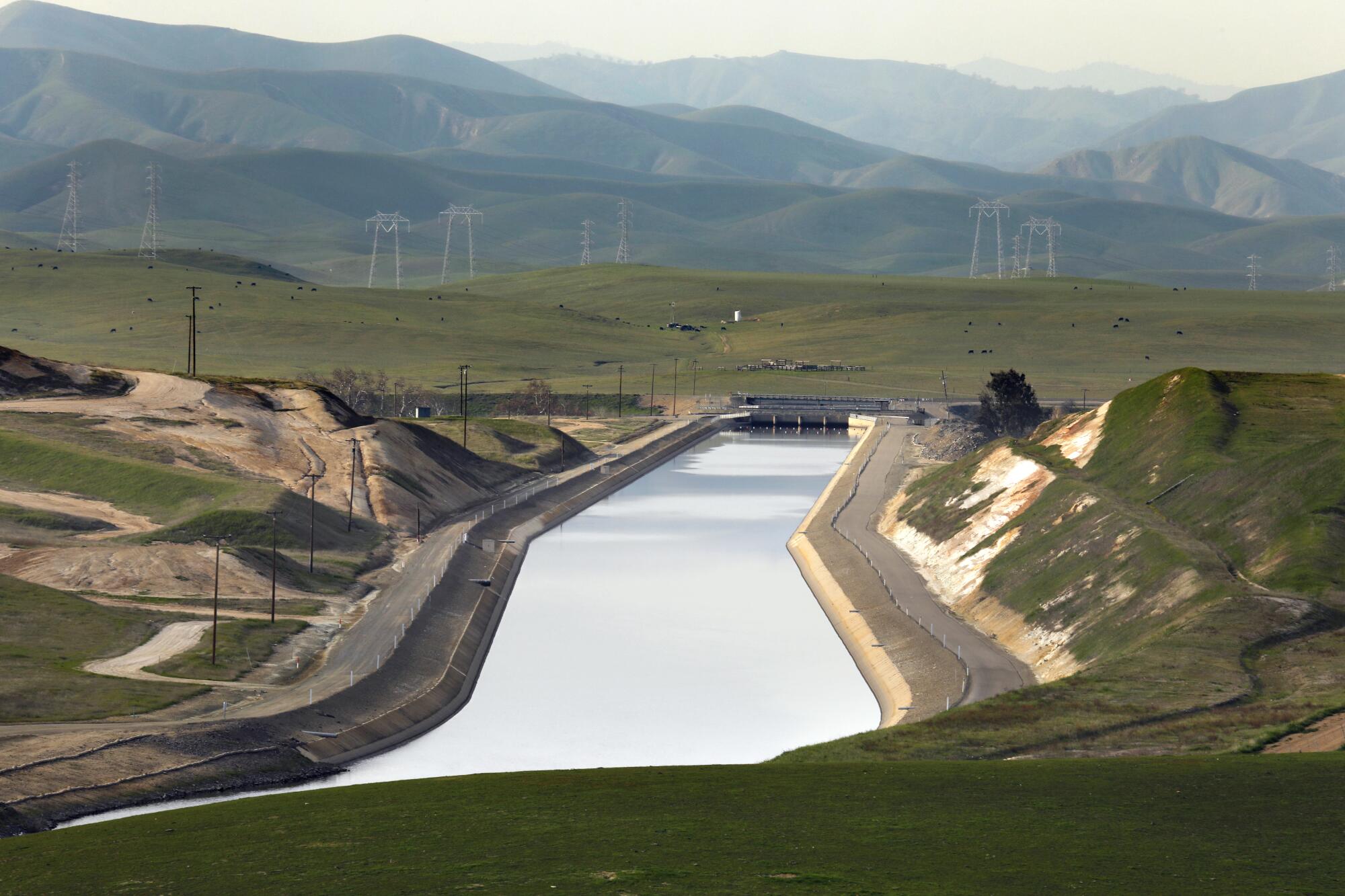
The Central Valley Project is one of the largest and most vital irrigation systems in the world. The federal government began construction in the 1930s, breaking ground on Shasta Dam in Northern California. Scaled up over decades, the system now includes 20 dams and reservoirs and countless canals that deliver water to farms and cities across the state.
The Delta-Mendota Canal is one of its major arteries. It takes water from the Sacramento-San Joaquin Delta and delivers that water — over 117 concrete-lined miles — to vast stretches of farmland in Fresno and Merced counties. The canal transformed life in this region when it began operating in the 1950s.
Suddenly, farmers who had been eking out a living with small yields were buying up large tracts of land. Tomatoes, cotton, cantaloupe and squash burst from the fields, part of the bounty that enables this valley to produce nearly half the fruits and nuts grown in the U.S.
But the water is not free. The federal government charges for it, albeit at reduced rates from those available on the open market. The water is delivered to farmers via water districts, such as the mighty Westlands Water District in western Fresno and Kings counties and the modest irrigation district Falaschi ran. These are public agencies, governed by boards elected by farmers. Each year, the government announces how much water the farmers will get at those reduced federal rates. In drought years, the federal government generally shrinks its allocations, forcing farmers to pump groundwater, buy what they need on the open market or let fields go fallow.
The government used to administer the Delta-Mendota Canal directly, but starting in the 1990s, it deferred that responsibility to the agency Walsh worked for. The water authority was accountable to the feds for every drop.
Walsh walked over to where the hat was spinning. He peered down at a standpipe that had once connected the Delta-Mendota Canal to an irrigation ditch that extends through adjacent farmland. The standpipe had been cemented closed and was no longer functional. At least in theory.
Walsh moved closer and heard a rushing noise in the pipe — the sound of water running hard and fast.
There must be a leak, he thought. But if the canal were leaking, there should have been water pooling around him. The field where he was standing was dry.
And he saw something even more peculiar. The abandoned pipe was old and rusted. But it had been fitted with a new gate to control the flow of water from canal to ditch. And that gate had a lock. Walsh’s water authority was responsible for every turnout on that canal. But he had never seen this lock, and he didn’t have a key.
“When I saw that, I thought: Someone is stealing water,” he said, a sentiment later echoed in court filings.
Walsh drove away, feeling troubled. The suspicious setup was on land that was part of the Panoche Water District, which for decades had been run by an outsize character named Dennis Falaschi.
Falaschi had grown up near Los Banos, and in the way of small towns, Walsh knew him from many settings. Falaschi, a standout high school athlete in his youth and later a coach, had refereed some of Walsh’s son’s football games. Walsh had gone to school with Falaschi family members.
Walsh also knew Falaschi through the world of water. He got the sense that Falaschi ran his water district with tight control and that his 30 or so employees were a close-knit group, some of them players Falaschi had coached. Falaschi was also tight with some of Walsh’s colleagues at the water authority. He had donated steak for staff cookouts, and Walsh had seen him gifting people with tickets to Oakland Raiders games.
Walsh went home that afternoon and didn’t immediately tell a soul what he had seen. He didn’t know exactly what he had stumbled across, but his gut told him this was going to be messy.
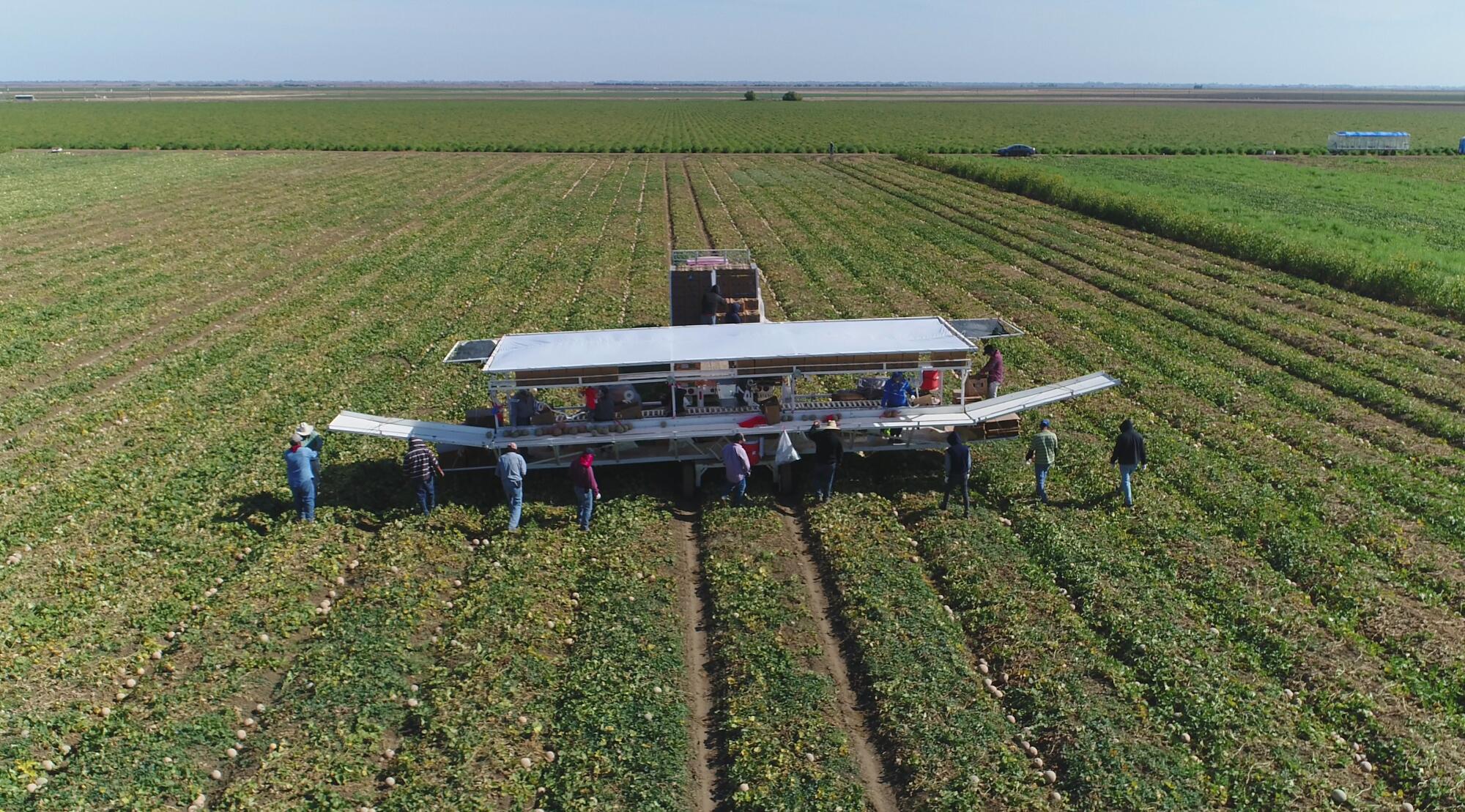
The San Joaquin Valley contains some of the most fertile farmland on Earth. But it is also largely dry, particularly on its western side, far from the rivers that pour out of the Sierra Nevada.
In and around Los Banos, the pursuit of water has been the key to power and wealth for more than a century. Henry Miller, the “Cattle King of California,” became one of the largest landowners in the U.S. in the late 19th century because he was able to gain the rights to a great deal of water across the San Joaquin Valley. The ranching empire he founded with Charles Lux was headquartered in Los Banos, and many believe its ethos of pursuing water at all costs is built into the DNA of the place.
Falaschi was a young boy in Dos Palos in southern Merced County when the Central Valley Project began pumping clean, clear water from Northern California to irrigate the valley. He saw firsthand how the arrival of cheap federal water changed everything. But Falaschi’s father was not one of the big farmers who could scoop up acres of newly irrigated land and get rich off the water project. He worked for the San Luis Canal Co. and grew what he could on the side.
Land barons seized control of the Tulare Lake Basin generations ago. This year’s destructive flooding left troubling questions about the power they wield.
When it was time to go to work, Falaschi followed his father into irrigation, according to an oral history he gave to Fresno State University, and landed with the Panoche Water District in the 1980s.
He arrived just as an environmental catastrophe of nightmarish proportions began to unfold.
It turned out that the scientists, engineers and farmers who had worked so hard to bring irrigation to the western San Joaquin Valley had failed to understand something crucial: a poison lurked in the sun-baked soil, and once the water came and the crops began to grow, it was unleashed.
In the summer of 1983, federal biologists began to notice something eerie at the nearby Kesterson National Wildlife Refuge. Harry Ohlendorf, a biologist for the U.S. Fish and Wildlife Service, later explained it to the Modesto Bee: It was too quiet. No bullfrogs were croaking. No birds were chirping. Barely any fish breaking the surface of ponds to bite at bugs.
As scientists began to investigate, they discovered something shocking: More than 40% of the birds that nested at Kesterson — an important stop on the North American flyway — were hatching eggs that were deformed.
“Many of the bird embryos had no eyes, no legs and no wings,” Ohlendorf told the Bee. “We were looking into eggs and seeing things we had never seen before.”
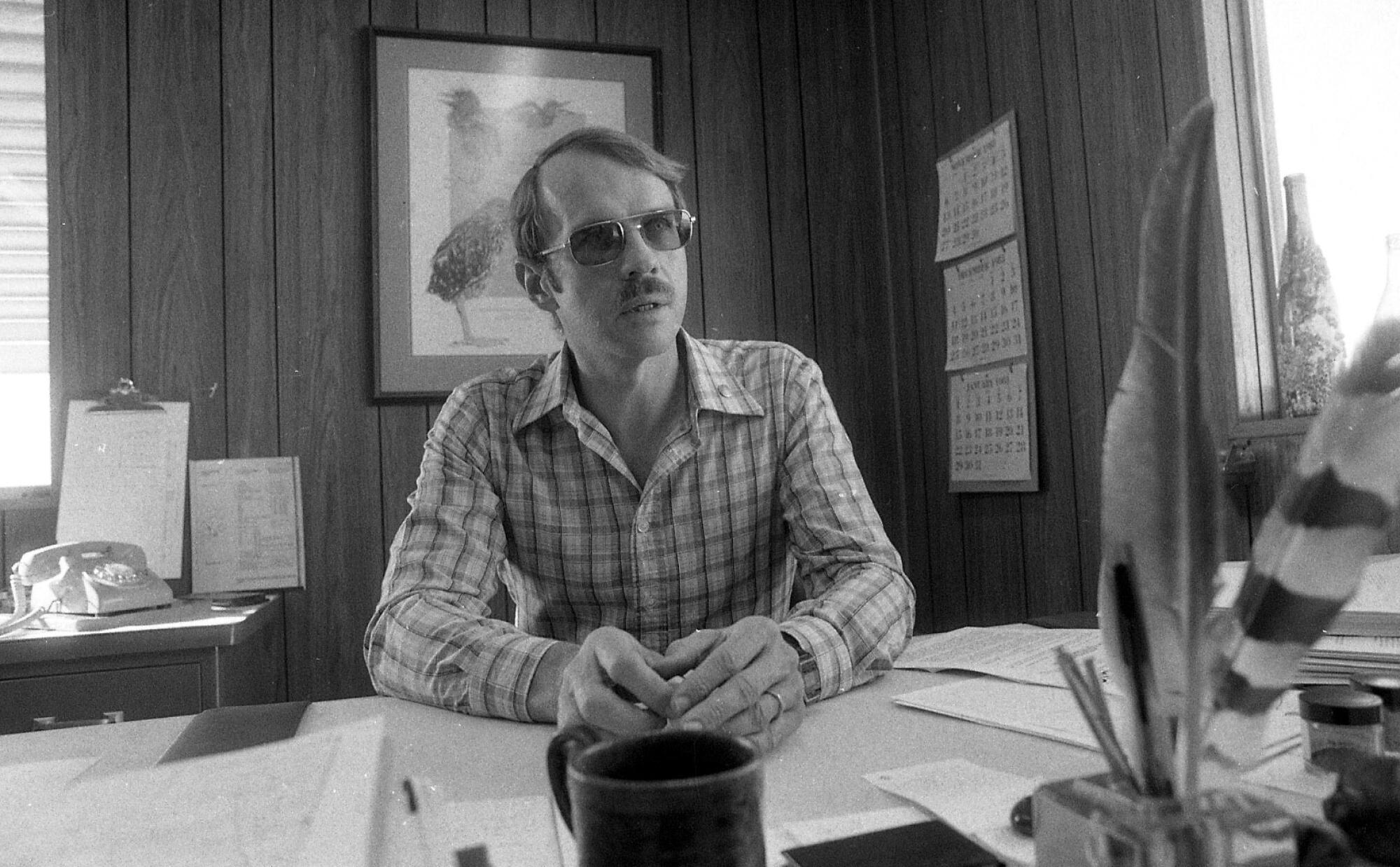
The culprit? Selenium.
When the Central Valley Project brought that clean, clear water to the valley, it spawned abundant crops. But all that water — now mixed with heavy concentrations of naturally occurring salts and minerals, as well as agricultural chemicals — had to go somewhere. Because the area’s groundwater aquifers are shallow, bound by a thick clay layer, the water couldn’t drain deep into the earth. Groundwater levels were rising and damaging crops.
So the government built a drainage system that funneled excess water via a canal to evaporation ponds inside Kesterson, on the theory that the ponds would provide additional refuge for birds.
It would have been an elegant solution — if it hadn’t resulted in mass death.
In 1985, a judge ordered the government to stop shunting drainage water to Kesterson. The Westlands Water District eventually sued, asserting the Bureau of Reclamation had promised to provide drainage when it built the Central Valley Project. A federal court agreed, potentially putting the federal government on the hook for more than $2 billion to fix the problem. Decades later, the legal battle continues.
As the government entities fought it out, Falaschi, by then with Panoche, put himself forward as the man who could help solve the drainage problems.
“Our livelihood is at stake,” he told the Merced Sun-Star in 1985, around the time he became the district’s general manager. The answer, he said, was technology.
Falaschi had bold ideas for reducing concentrations of salt and selenium in the soil, from planting crops that could absorb the toxins to novel water treatment methods. In the years to come, he caught the ear of influential people at the Bureau of Reclamation and state Department of Water Resources desperate for answers.
In 2011, the Bureau of Reclamation awarded Panoche a $4-million grant to pursue “demonstration projects,” including water treatment technology that supposedly could reduce selenium concentrations. The federal government agreed to fund a treatment plant, and over the next several years would funnel $67 million into the project, according to a 2019 federal audit.
For a time, Falaschi became the public face of the Kesterson “fix,” meeting with visiting dignitaries and earnest reporters to tout the potential of his projects.
But behind the glowing headlines, trouble was brewing, and by 2015 life at Panoche was about to implode.
Walsh, the hydrographer who spotted the illicit pipeline in the Delta-Mendota Canal in spring 2015, spent the weekend worrying what to do about it.
The problem, as he saw it, was that many of his supervisors at the local water authority had ties to people at the Panoche Water District. If he blew the whistle on what appeared to be water diversion, whose loyalties might he be crossing?
Eventually, he said, he compiled a file with what he had found. “If anything happens to me,” he told his children, “this file right here is the reason.”
The following week, he emailed a top boss, asked for a meeting and shared what he had found.
News of Walsh’s find made its way to the Bureau of Reclamation, and from there to the FBI. Around the same time, the FBI got a second tip about Panoche.
In September 2015, according to a criminal complaint later filed in state court, a private investigator walked into the Fresno office of the FBI. The investigator, who was working for a farmer angry about his water rates, had been digging into Panoche’s records and said he had come across evidence that the water district was playing loose with public funds.
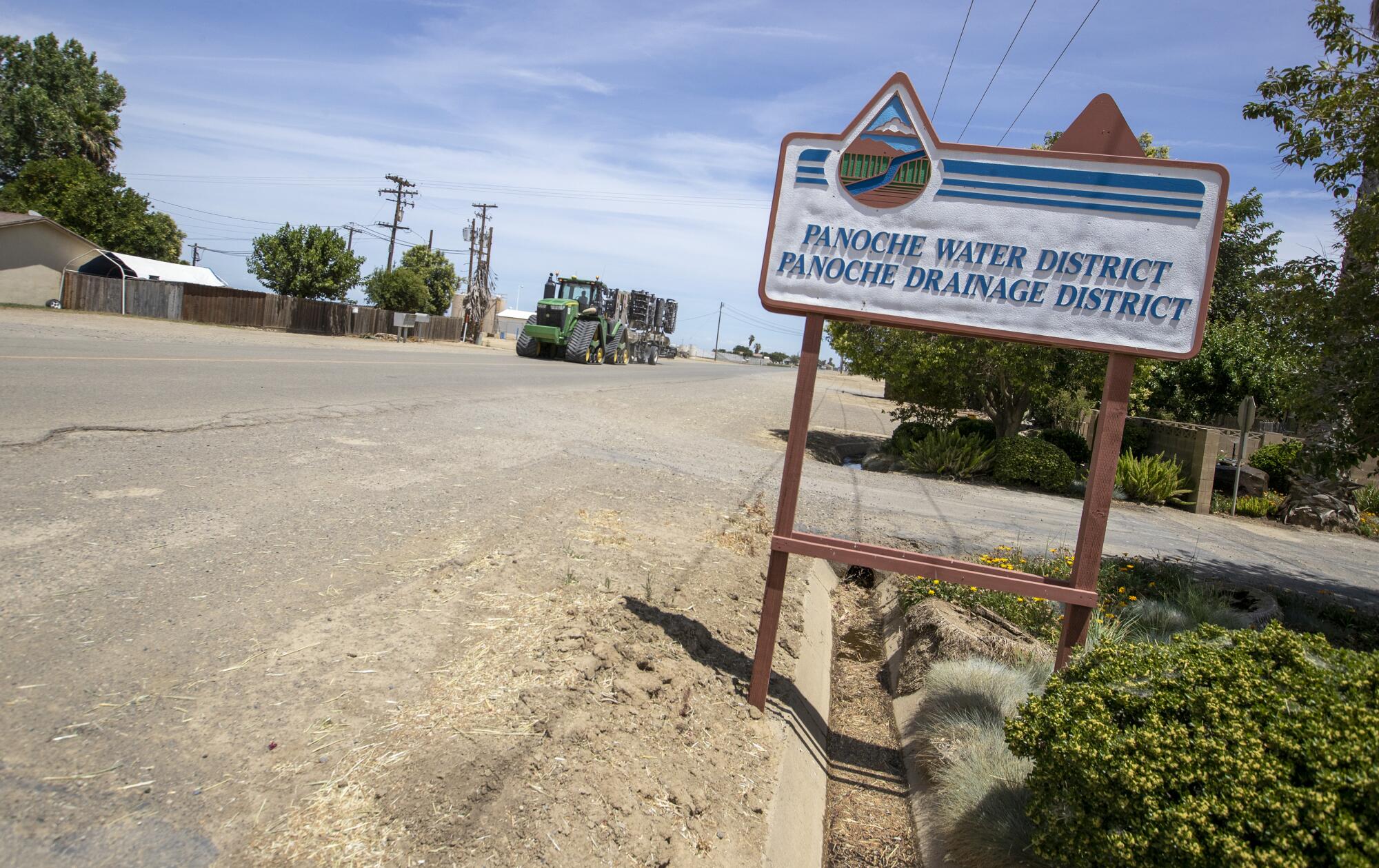
By 2016, the water district was crawling with investigators. The probe was so widespread, according to testimony in a 2019 civil case, that eventually almost every employee was interviewed.
There was the investigation into water theft. Allegations that Falaschi and other Panoche employees had embezzled public funds. Potential violations of hazardous waste laws.
The U.S. attorney’s office kept the water case because it involved possible theft of federal property. The embezzlement allegations wound up with the state. In June 2016, the California state controller announced a review of the water district’s finances.
That review went public in early 2017. The agency issued a news release alleging “an egregious lack of spending oversight.”
Among the whoppers, according to the controller: The district had been handing out interest-free “loans” to employees, with little paperwork. Six workers had been given free housing. Falaschi had been living rent-free since 1992, the controller said.
The district also paid for about 50 trucks and cars that employees used as their own. And employees racked up tens of thousands of dollars on district-paid credit cards between 2013 and 2015 alone. The charges included season tickets to the Raiders and Oakland A’s, concert tickets and shopping sprees at Ralph Lauren, Nike and Sunglass Hut.
Panoche officials responded by telling auditors they had fixed many of the problems the review had identified.
A few months later, another scandal: The Department of Toxic Substances Control said the water district had been burying hazardous waste — more than 80 barrels — on property near the selenium treatment plant rather than disposing of it properly.
Falaschi stepped down, but accusations continued to mount.
In 2018, state prosecutors filed felony charges against Falaschi and four other employees. Falaschi was charged with a host of misspending, including buying two Reno slot machines with his district credit card. An employee was accused of spending more than $4,000 of district money on a kitchen remodel. According to the complaint, the district spent tens of thousands to cover car repairs for employees, as well as more than $14,000 to repair a 1986 Porsche 911 owned by one of Falaschi’s friends.
Falaschi and other employees professed their innocence, and in 2020 a judge dismissed some of the charges. The judge, however, refused to toss four felony charges against Falaschi, and the case remains active pending the outcome of the federal proceedings.
In 2021, the Panoche district, by then under new management, agreed to reimburse the Bureau of Reclamation nearly $7.5 million for unauthorized diversions of water from the Delta-Mendota from 2009 to 2015, a fraction of the period federal officials contend water was being stolen.
But that was not the end of it. In April 2022, seven years after Walsh went to his bosses with his suspicions, a federal grand jury returned a five-count indictment accusing Falaschi of orchestrating a decades-long theft of government water and lying about his income on his taxes. In 2016 alone, according to the indictment, Falaschi took in nearly $900,000 in salary and unreported income.
The indictment lays out the alleged scheme:
The Panoche Water District is supposed to purchase federal water by the acre-foot at set rates, drawing it from the Delta-Mendota Canal through metered gates. The water district combines that water with other sources and uses its irrigation system to distribute water to farmers. Any water it doesn’t use is supposed to be delivered back to the Delta-Mendota for water credits.
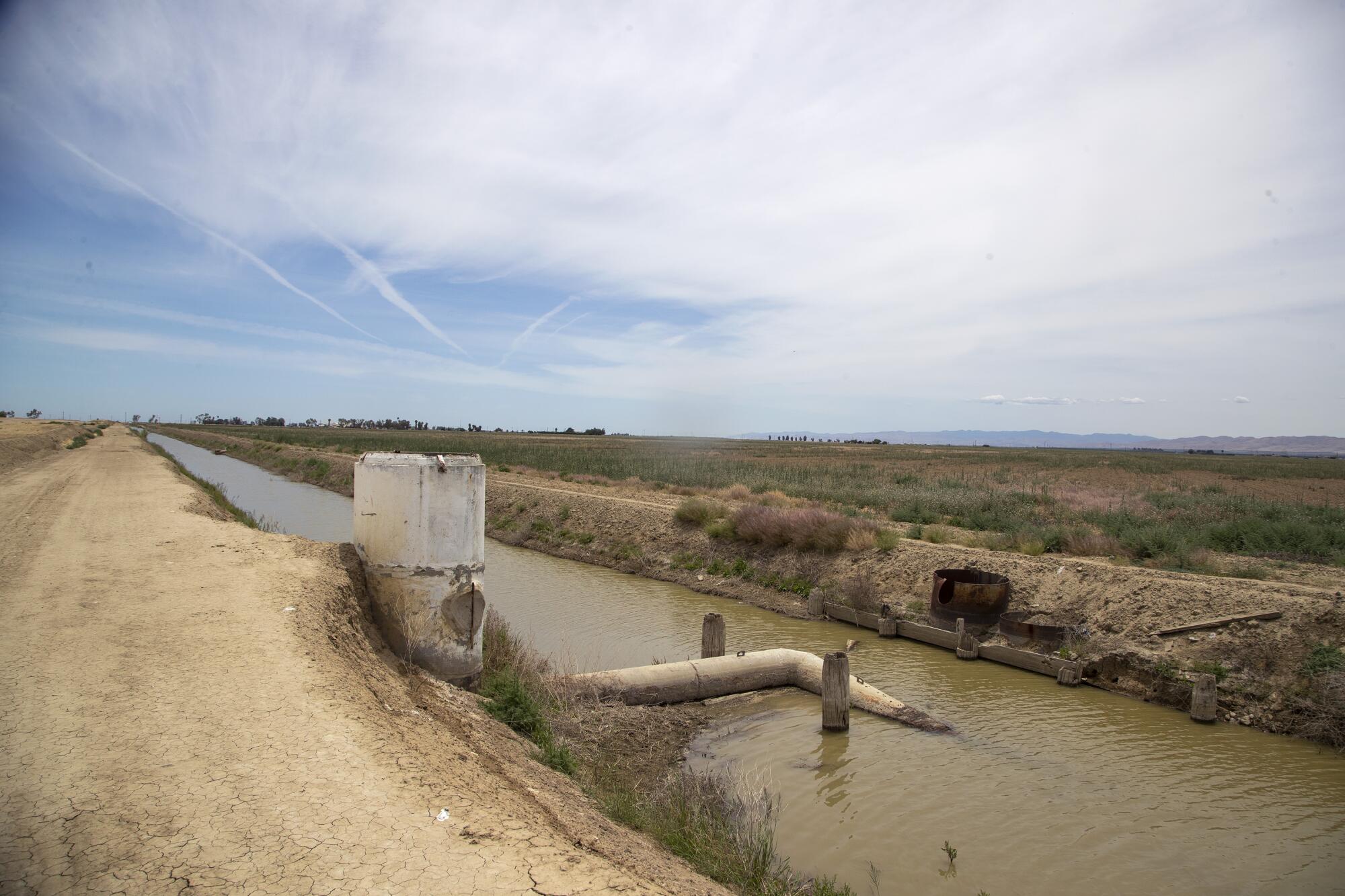
But in 1992, the indictment alleges, one of Falaschi’s employees informed him that an old turnout on the canal that had been cemented shut years earlier was leaking through the cement. Instead of reporting the leak, Falaschi allegedly told his employee to install a gate that could be opened and closed, to put a lock on that gate, and to do it all in such a way that the setup wasn’t easily visible.
From that day forward, Falaschi allegedly instructed workers — at least seven over the years — to go out, often at night, and divert water through the illicit connection into the district’s water system.
Once in the Panoche system, according to the allegations, the purloined water was sold to farmers or sent back to the canal in exchange for credits. To account for the bounty, Falaschi had employees classify the stolen water as reclaimed runoff from area farms, according to the indictment.
The same day the indictment came down, federal prosecutors filed documents that said they had reached a plea deal with one of Falaschi’s associates at a neighboring water district. In an exhibit that laid out the factual basis for the plea deal, prosecutors said Jeffrey Bryant, general manager of the Firebaugh Canal District, had brokered more than $9 million in water sales on behalf of an unnamed farmer between 2013 and 2015 and been paid a commission. Prosecutors also said that Bryant, Falaschi and a third person had sold $1.9 million worth of water and split the proceeds.
Bryant, who agreed to plead guilty to filing a false tax return related to water sale proceeds, declined a Times request for comment. His attorney, Mark Coleman, said in an interview that the factual basis has been “inartfully drawn” and Falaschi was irrelevant to Bryant’s case. “He is charged with tax fraud,” Coleman said. “He is not charged with stealing water.”
Falaschi, in court filings, proclaimed his own innocence for more than a year. He argued that no water theft had occurred because the district was entitled to “seepage” from the canal. He also said he had “never received a penny for the water.”
The case was set for a March trial, before federal prosecutors in February filed documents indicating Falaschi was changing his plea. Days, his attorney, did not respond to requests to discuss the case or what prompted the change.
The farm barons of Tulare Lake Basin want to continue pumping groundwater at volumes collapsing the San Joaquin Valley. That puts the region at greater risk of damaging floods — and in greater need of taxpayer bailouts.
Even as the federal case appears poised for closure, the ripple effects won’t easily settle.
The water district Falaschi ran for 30 years has a new director, Patrick McGowan, and its board has promised better accounting. After Falaschi’s departure, some Panoche employees were fired or saw their pay curtailed. A few sued the district. Zavala was fired despite cooperating with federal investigators, and lost his lawsuit claiming retaliation. He could not be reached for comment.
Walsh, the hydrographer who first spotted the spinning hat, also ended up in court. In December 2023, he sued the San Luis & Delta-Mendota Water Authority, alleging his bosses had retaliated against him by denying him promotions after he reported his suspicions. That lawsuit is ongoing.
The Bureau of Reclamation, meanwhile, quietly abandoned the $67-million selenium treatment plant it had started under Falaschi’s tenure, after a stinging 2019 audit found the bureau had paid “inappropriate costs” to Panoche’s drainage district arm for a plant that didn’t work. The region’s drainage problems continue.
As for the farmers? The episode is clouded in grays.
If Falaschi was stealing water, several people said, farmers did not know and wouldn’t approve. But they also appreciate that during years of punishing drought, Falaschi had found a way to bring them water.
“I see him as a little bit like Robin Hood,” said longtime farmer Joe Del Bosque.
After all, he noted, it wasn’t Falaschi’s fault the canal started leaking.
“He didn’t cause the leaking,” Del Bosque said. “He just happened to take advantage of it for the good of the farmers.”
More to Read
Subscriber Exclusive Alert
If you're an L.A. Times subscriber, you can sign up to get alerts about early or entirely exclusive content.
You may occasionally receive promotional content from the Los Angeles Times.






